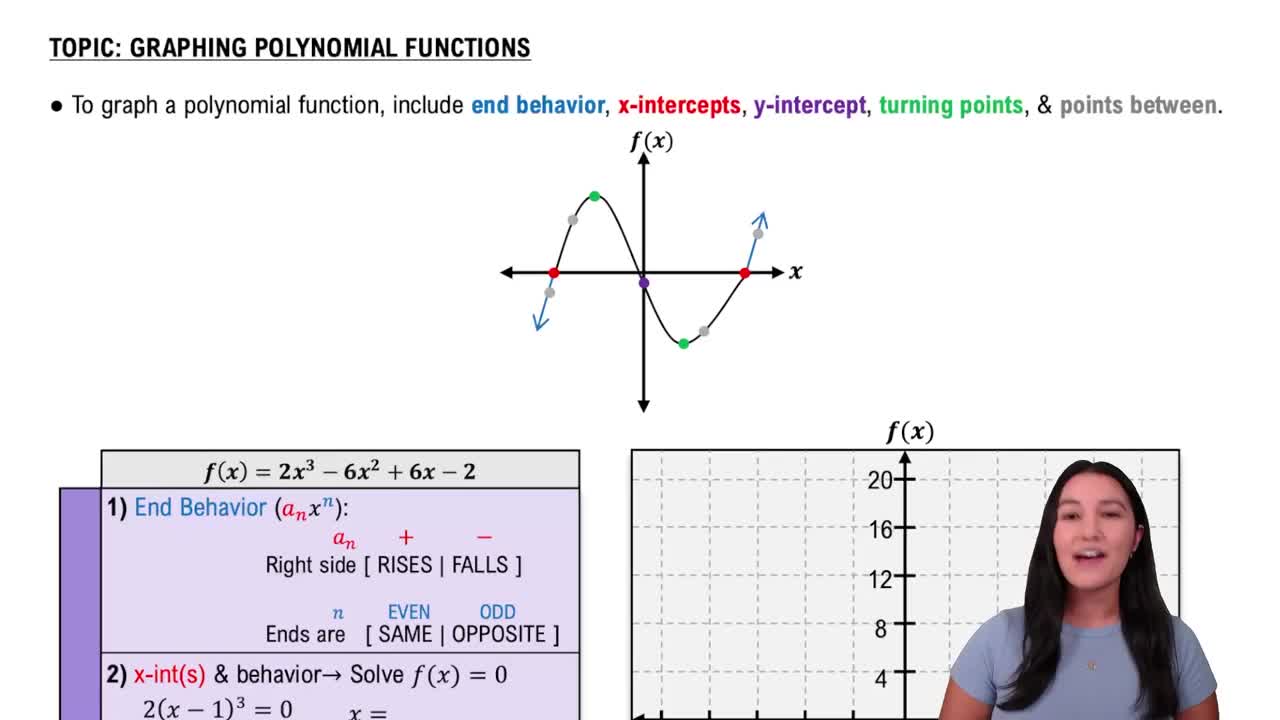Table of contents
- 0. Review of Algebra4h 16m
- 1. Equations & Inequalities3h 18m
- 2. Graphs of Equations43m
- 3. Functions2h 17m
- 4. Polynomial Functions1h 44m
- 5. Rational Functions1h 23m
- 6. Exponential & Logarithmic Functions2h 28m
- 7. Systems of Equations & Matrices4h 6m
- 8. Conic Sections2h 23m
- 9. Sequences, Series, & Induction1h 19m
- 10. Combinatorics & Probability1h 45m
1. Equations & Inequalities
Linear Inequalities
Problem 35d
Textbook Question
Solve each polynomial inequality in Exercises 1–42 and graph the solution set on a real number line. Express each solution set in interval notation. x^3+2x^2−x−2≥0
 Verified step by step guidance
Verified step by step guidance1
<Step 1: Factor the polynomial.> Start by attempting to factor the polynomial \(x^3 + 2x^2 - x - 2\). You can use the method of grouping or synthetic division to find the factors.
<Step 2: Find the critical points.> Set the factored polynomial equal to zero to find the critical points. These are the values of \(x\) where the polynomial changes sign.
<Step 3: Test intervals.> Use the critical points to divide the number line into intervals. Choose a test point from each interval and substitute it into the original inequality \(x^3 + 2x^2 - x - 2 \geq 0\) to determine if the interval satisfies the inequality.
<Step 4: Determine the solution set.> Based on the test results, determine which intervals satisfy the inequality. Include the critical points in the solution set if the inequality is \(\geq\) or \(\leq\).
<Step 5: Express the solution in interval notation.> Write the solution set in interval notation, indicating the intervals where the inequality holds true.
Recommended similar problem, with video answer:
 Verified Solution
Verified SolutionThis video solution was recommended by our tutors as helpful for the problem above
Video duration:
8mPlay a video:
Was this helpful?
Key Concepts
Here are the essential concepts you must grasp in order to answer the question correctly.
Polynomial Inequalities
Polynomial inequalities involve expressions where a polynomial is compared to a value, typically zero, using inequality symbols such as ≥, ≤, >, or <. To solve these inequalities, one must find the values of the variable that make the inequality true, often by determining the roots of the polynomial and testing intervals between these roots.
Recommended video:

Linear Inequalities
Interval Notation
Interval notation is a mathematical notation used to represent a range of values on the real number line. It uses parentheses and brackets to indicate whether endpoints are included (closed intervals) or excluded (open intervals). For example, the interval [a, b) includes 'a' but not 'b', while (a, b) excludes both endpoints.
Recommended video:

Interval Notation
Graphing Solution Sets
Graphing solution sets on a real number line visually represents the values that satisfy the inequality. This involves marking the roots of the polynomial and shading the appropriate regions based on the sign of the polynomial in each interval. This graphical representation helps in understanding the solution set and its relation to the inequality.
Recommended video:

Graphing Polynomial Functions
Related Videos
Related Practice












